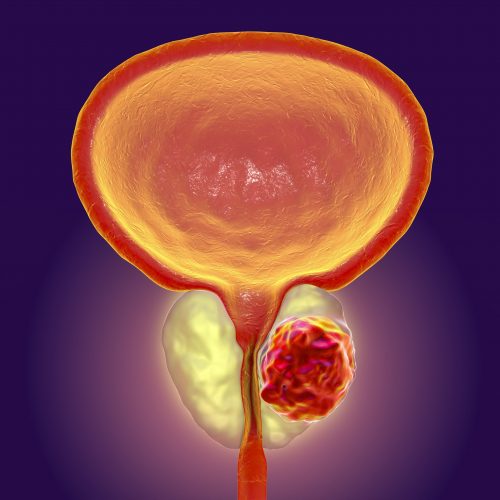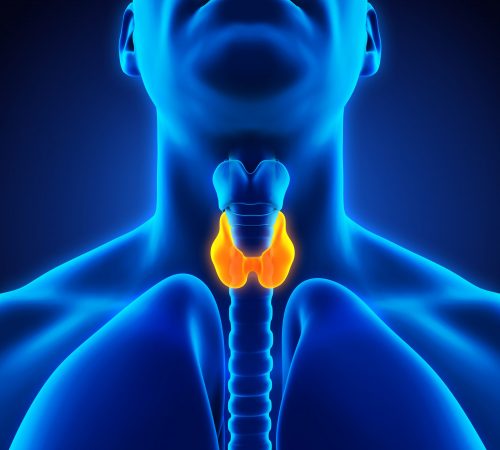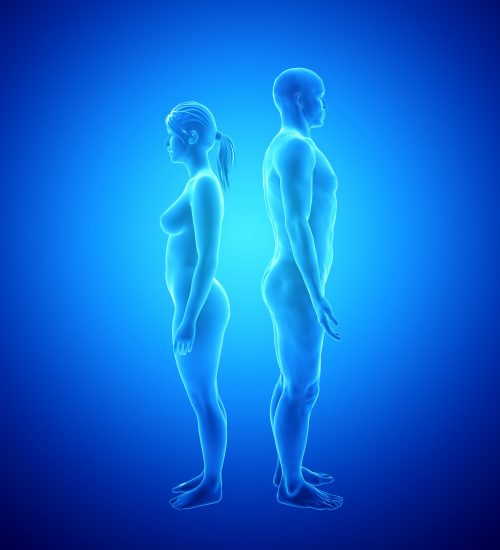Dispelling the Myths: Prostate Cancer & Testosterone Replacement Therapy (TRT)

At The Men’s Health Clinic, we believe in progressive medicine, using the latest concrete evidence to identify potential new ways to better improve the health of our patients. Something that’s quite essential to this process is helping pass on this new-found and concrete evidence backed knowledge and educate others. Thus, we need to address old and outdated views in medicine and for TMHC that means addressing outdated TRT hypotheses.
So, I welcome you to the beginning of a series of blogs that address perceived positive and/or negative risks of TRT or healthy normal male androgen levels. The next few articles are here to specifically address old and outdated views on TRT that still exist within not only the general population, but also within medical communities.
Now that our introduction is done here, let’s move onto the main show!
Prostate Cancer – The Facts
Cancer is a word nobody likes to hear. A group of diseases that entail abnormal cell growth, where the cells reproduce uncontrollably. Those cells can potentially invade or spread to other parts of the body. We often think of cancer as the end of the road, but that’s not true – we can fight it.
Based on 2018 estimates, there was well over one million new cases of prostate cancer reported worldwide in 2018. Prostate cancer is the second most frequent cause of cancer in men, with lung cancer being first, and the 5th leading cause of death worldwide 1. Both the incidence and mortality of prostate cancer correlate with an increased age, where the average age at time of diagnosis is 66 years 1.
Prostate cancer may often be asymptomatic during the early stages. Therefore, you are encouraged to get your prostate checked out at your later years of life. Yes, this means a finger in the bum, but it’s better than having cancer. Generally, the first symptoms noticed may be difficulty with urination, an increased frequency of urination, and nocturia (waking up in the night to pee), which often occurs due to prostatic hypertrophy (prostate growth) 1. As the cancer develops, one may notice urinary retention (inability to completely empty the bladder) and back pain.
Prostate cancer can also be detected early on by measuring plasma levels of prostate-specific antigen (PSA) where a PSA greater than 4 ng/mL is typically cause for concern. This is a glycoprotein (protein attached to glycogen molecule) that’s expressed (produced) by prostate tissue. But you can also have elevated PSA without prostate cancer; a tissue biopsy will confirm the diagnosis.
On a more positive note, the 5-year survival rate among men in the USA diagnosed with prostate cancer is ~98% 2 and among patients diagnosed between 2003 to 2007 in Europe it was 83%, with a higher survival rate among southern and central European countries at 88% 3.
Let’s move onto the risk factors for Prostate cancer, so you are equipped with the knowledge to help reduce your own risk.
Risk Factors
There are plenty of factors, aside from age, involved in the pathogenesis of the disease. These include (but not limited to) diet, genes, and physical activity. Let’s focus on the non-sex hormone related ones first, with short breakdowns.
Genes
A family history and genetic factors may contribute to 5% of cases 4,5. There are a few major genes that can increase the risk of prostate cancer quite dramatically, though they are out of scope for this article. If you are interested, do read the ‘Genetic predisposition, genomics, and epigenomes in prostate cancer’ section by Wang et al., 2018.
Diet
Diet plays quite an essential role in the development of prostate cancer, and this has been evidenced by many studies. The “westernised” lifestyle has unfortunately shifted to an increase incidence of prostate cancer, even when accounting for all other variables 1.
Animal Saturated Fats
There’s a demonstrated a statistically significant positive correlation between prostate cancer incidence and saturated animal fat intake and moreover a general high fat intake 6,7. This has been showcased in case-control studies in patients younger or equal to 60 years 8. Why is this? It may be due to:
- Increased levels of reactive oxygen species (ROS) that can encourage cancer growth via eventual DNA damage
- Increased leukotrienes and prostaglandins from lipid metabolism, known to play a role in cancer development
- Increased basal metabolism, insulin growth factor and tumour proliferation.
Point three should make it clear that very high levels of carbohydrates could further encourage prostate cancer development. It is important to note that many authors consider the angle of saturated fat increasing androgen levels being a contributing factor. I disagree; I’ll get into why later.
Corn Oil
Corn-oil based products could also increase the risk due to being high in linoleic acid, a highly abundant omega-6 fatty acid. Arachidonic acid is a metabolite of linoleic acid and, in short, it gives rise to inflammatory compounds that can effectively encourage cancer growth. In contrast, omega-3 fatty acids are amazing in general and are highly protective against cancer growth in general too 9.
Red Meat
Red meat is also problematic, which I’m sure you’ll have already heard before. It’s been well linked with prostate carcinogenesis, among other cancers. Those consuming five or more servings of processed red meats per week have a much higher risk of prostate cancer, when compared to those having fewer 10. Eat it in moderation, but have plenty of foods high in omega-3 such as fatty fishes and nuts too. The issue with red meat is that cooking it at high temperatures of 125 to 300 °C, can cause the formation of aromatic hydrocarbons and mutagenic heterocyclic amines 1. These increase the risk of cancer formation. Grilled and/or BBQ meat can also cause the formation of N-nitroso compounds which can cause DNA-damage and production of ROS, which also cause DNA damage.
Please don’t take this as a ‘don’t eat red-meat’, just as a ‘eat LESS red-meat’. I know plenty of bodybuilders will religiously eat red-meat daily and although it may not seem problematic now, risk factors can still add up.
Dairy Foods
Interestingly, it’s been shown that dairy foods are generally associated with elevated prostate cancer risk; calcium at greater than 2g per day appears to be the causative factor 1. So, if you’re drinking over 1.5 litres of milk per day or equivalent, it could become an issue. I’m sorry to anyone doing the GOMAD diet (and from personal experience I could never recommend this diet, it’s not the healthiest).
Alcohol
Heavy alcohol intake of more than three drinks per day may well be a risk for prostate cancer development, too 1.
High Calorie Diets
High calorie diets are also a risk factor for prostate cancer development 1. Get enough of the macro and micronutrients that you need in your diet, and this should be enough to grow (you do not need a ‘surplus’, but that’s a debate for another day..).
Cruciferous Vegetables
Cruciferous foods such as broccoli, brussel sprouts, cauliflower, cabbage and turnips reduce prostate cancer risk 1. They may have anticancer properties which are likely mediated by a few compounds, including indole-3-carbinol 11.
Soy & Green Tea
Soy and green tea-based products also reduce prostate cancer risk, possibly due to a few mechanisms 1. Tomatoes, and more so lycopene from tomatoes, also appear to reduce prostate cancer risk.
Vitamin D
Vitamin D deficiency has been shown to increase prostate cancer risk development, and there is large biochemical evidence for this 1. Make sure to either get enough sun (don’t get too much UV though) or vitamin D at a maximum of 5000iu per day.
Selenium
Selenium in most studies have shown a risk reduction of 50-60% of prostate cancer development 12,13.
Obesity & Physical Activity
I think it comes as no surprise that obesity is very well linked to advanced and aggressive prostate cancer 14,15. One possible reason for this is due to altered hormone and metabolic profiles. Elevated insulin, due to the insulin resistance associated with obesity (and particularly with lack of exercise) can promote prostate cancer growth. Furthermore, in obesity we note an elevation in oestradiol levels, which can encourage prostate cancer growth 16. Exercise can naturally decrease the risk of prostate and other cancers 1.
Let’s expand on the point regarding Oestradiol – What role do your sex hormones play?
Sex Hormones & Prostate Cancer
First, I need to make it clear that there are different types of prostate cancers. They are as follows:
1. Acinar Adenocarcinoma
Develops in gland cells which line the prostate gland, and is the most common.
2. Ductal Adenocarcinoma
Starts in the cells that line the tubes of the prostate gland. Tend to grow and spread more quickly than acinar adenocarcinomas.
3. Transitional Cell Cancer
Starts in the cells that line the tubes which carry urine out of your body (urethra). Generally, this starts in the bladder and spreads to the prostate.
4. Squamous Cell Cancer
Develops from flat cells that cover the prostate; they tend to grow and spread more quickly than adenocarcinomas.
5. Small Cell Prostate Cancer
Made up of small round cells; a neuroendocrine cancer.
Historically, there has been a belief that TRT will increase the risk of prostate cancer 17. Naturally, that extends to the theory that androgens must therefore promote prostate cancer. This is clear in experimental systems 18. But… there’s not much clear evidence that increases in endogenous testosterone levels promote prostate cancer development in humans. Unfortunately, past experimental and historical data on the progression of prostate cancer following TRT has led to the firm belief that TRT will ultimately promote disease progression in prostate cancer patients 17. But studies are increasingly demonstrating no increase in prostate cancer incidence among men on TRT; furthermore, no discernible increase in disease progression in prostate cancer on TRT has been observed. So, what’s up with the idea that Testosterone and prostate cancer are related?
Testosterone & Dihydrotestosterone (DHT)
Well, testosterone’s metabolite dihydrotestosterone (DHT) does indeed mediate the development of the prostate, particularly when an adult. Excess DHT can lead to benign prostatic hypertrophy 18. Historically, it was proposed by Huggins and Hodges (1941) that prostate cancer growth was specifically drive by androgens, as they observed benefits after castrating prostate cancer patients. This appears to be validated by cell studies, and androgen deprivation therapy does remain a mainstay in prostate cancer treatment. But again, in clinical studies looking at patients, it’s mostly the contrary. Some studies demonstrate no association, some show low testosterone, some show elevated. Biopsies show conflicting results too 18.
What we do know is TRT does not increase the risk of prostate cancer in current studies; so, there’s little reason to believe androgen deprivation therapy would be the sole potential therapeutic treatment method.
Oestrogens
Something that’s often glanced over is the fact that us males also have oestradiol; oestrogens have been implicated as potential agents in the development and progression of prostate cancer 16. More specifically, oestradiol that binds to the oestrogen receptor alpha (ERα), where this receptor is associated with more aggressive tumour development in animal studies. If you use testosterone alone in Noble rat studies, the induction of prostate cancer is 40%, but add testosterone and oestrogen and it’s 100%; DHT induced cancer in only 4% of the rats 16. To those saying we aren’t rats, clinical studies do show that oestrogen plays a role in prostate cancer development. There’s also evidence to suggest that antioestrogens can be both preventive and therapeutic for prostate cancer 19.
The T:E Ratio
There are a few important points to consider here:
- Oestrogens are necessary to develop prostate cancer in most cases.
- Testosterone is also important for prostate cancer development, but it’s not as significant a factor as Oestrogens are.
- DHT plays a smaller role in all of this.
What’s been clearly shown in clinical literature is that an increase in an E:T serum ratio will absolutely have an increased risk of developing prostate cancer, especially as one gets older 20. Why is this? Proposed mechanisms include the following 16:
- Epigenetic modifications (changes in which genes are active, which can change throughout life due to external factors).
- Direct genotoxicity via Oestrogen metabolites (DNA damage), where this is supported by gene case-studies.
- Elevated prolactin (elevated oestrogen can increase prolactin); at least in rat studies.
- Oestrogen induced immunotoxicity or inflammatory changes. This has also been supported by some human studies. Some studies also show decreased prostate cancer risk when using nonsteroidal anti-inflammatory drugs.
- Prostatic ER-mediated changes, ie. ERα activation; blocking it appears to reduce detection of prostate cancer in subsequent biopsies. Which mediates inflammation. The ERβ is the predominant ER in developing human prostates.
On the last point, ERα knockout mice (lack ERα) appear to not develop prostate cancer, but ERβ knockout mice do appear to develop it. In-fact, ERβ seems to be protective against developing prostate cancer. ERα may mediate this by also increasing the activity of certain cancer-promoting genes (namely, TMPRSS2-ERG which is a gene fusion). How true this specifically is within humans is another story; we just know that oestrogen is important in prostate cancer development, particularly aggressive prostate cancer.
If you managed to get this far, you’ll be wondering what T:E ratio is best to avoid increasing the risk of prostate cancer. I implore you to read the first article I wrote for The Men’s Health Clinic, ‘The Importance of Oestrogen in TRT’ for further insight into this. But, also bear in mind that you will need to adjust according to serum levels of prostate specific antigen (PSA), as it is often elevated in the presence of prostate cancer. It’s otherwise produced for ejaculate; it liquefies semen to allow sperm to swim freely.
What you need to take away from this is an understanding that Testosterone alone is not responsible for prostate cancer development. You need Oestradiol, but a high Oestrogen to Testosterone ratio could increase the risk of prostate cancer. Keep Oestrogen normalised and monitor your PSA with your doctor. You can control it by natural means (see ‘Controlling Oestrogen Without Pharmaceutical Drugs’) or with via an aromatase Inhibitor under an expert medical doctor’s supervision.
How to Screen for Prostate Cancer
We’ve talked a lot about causes of prostate cancer, but not on the methods used to screen for it, other than monitoring PSA.
A raised PSA level is about 3ng/mL or higher in men aged 50 +. But, having elevated PSA can also be due to an enlarged prostate, prostatitis (inflammation), or a urinary infection.
Further follow up checks are warranted using digital rectal examination (DRE), particularly if you’re over 45 where the risk of prostate cancer increases dramatically. This will involve having a finger inserted into your prostate by a doctor or nurse. Don’t worry, lubricant and a glove are used; it’s a short assessment. You MUST get a DRE if you’re over 45; don’t be afraid of it. Prostate cancer is much, much worse than a DRE.
If you are over 40 years old and on Testosterone Replacement Therapy, The BSSM guidelines recommend a baseline DRE, alongside regular monitoring of your PSA.
To really confirm prostate cancer, an MRI is the gold standard. In addition to this, core needle biopsies may be performed, which involve taking small samples of the prostate. The cells are then looked at under a microscope. Please don’t worry if you ever need this done, it only causes some brief discomfort and is generally painless as local anaesthetic is used and the biopsy instrument is designed to not cause any pain. This combined procedure will provide a highly accurate assessment of whether you have prostate cancer, or not.
Recommendations
- Eat Less Red Meat – Three or less servings per week is good
- Eat Less Animal Saturated Fats
- Eat More Omega-3 Based Foods – Fatty fish and nuts come to mind
- Eat More Cruciferous Vegetables – i.e. broccoli or cabbage
- Have More Soy-Based Products & Green Tea In Your Diet
- Get Enough Vitamin D – Max 5000iu per day
- Don’t Go Overboard On Dairy – Keep calcium below 2g per day
- Avoid Going Into Calorie Surplus Too Often
- Avoid Corn Oil Based Foods
- Consider Supplementing Selenium – 70-350mcg per day is likely enough
- Control Your Oestrogen With Your Doctor – Keeping your T:E ratio in check
- Identify Causes Of Elevated Prolactin If Oestrogen Is Normal – See our article on Prolactin
References
- Rawla P. Epidemiology of Prostate Cancer. World J Oncol. 2019;10(2):63-89. doi:10.14740/wjon1191
- SEER*Explorer Application. https://seer.cancer.gov/explorer/application.html?site=1&data_type=1&graph_type=2&compareBy=sex&chk_sex_3=3&chk_sex_2=2&race=1&age_range=1&hdn_stage=101&rate_type=2&advopt_precision=1&advopt_display=2. Accessed November 8, 2020.
- Epidemiology of prostate cancer in Europe | EU Science Hub. https://ec.europa.eu/jrc/en/publication/epidemiology-prostate-cancer-europe. Accessed November 8, 2020.
- Gallagher RP, Fleshner N. Prostate cancer: 3. Individual risk factors. CMAJ. 1998;159(7):807-813. https://www.ncbi.nlm.nih.gov/pmc/articles/PMC1232741/. Accessed November 8, 2020.
- Mohler J, Bahnson RR, Boston B, et al. Prostate cancer: Clinical practice guidelines in oncologyTM. JNCCN J Natl Compr Cancer Netw. 2010;8(2):162-200. doi:10.6004/jnccn.2010.0012
- Howell MA. Factor analysis of international cancer mortality data and per capita food consumption. Br J Cancer. 1974;29(4):328-336. doi:10.1038/bjc.1974.75
- Armstrong B, Doll R. Environmental factors and cancer incidence and mortality in different countries, with special reference to dietary practices. Int J Cancer. 1975;15(4):617-631. doi:10.1002/ijc.2910150411
- Aronson WJ, Barnard RJ, Freedland SJ, et al. Growth Inhibitory Effect of Low Fat Diet on Prostate Cancer Cells: Results of a Prospective, Randomized Dietary Intervention Trial in Men With Prostate Cancer. J Urol. 2010;183(1):345-350. doi:10.1016/j.juro.2009.08.104
- Berquin IM, Min Y, Wu R, et al. Modulation of prostate cancer genetic risk by omega-3 and omega-6 fatty acids. J Clin Invest. 2007;117(7):1866-1875. doi:10.1172/JCI31494
- Rohrmann S, Platz EA, Kavanaugh CJ, Thuita L, Hoffman SC, Helzlsouer KJ. Meat and dairy consumption and subsequent risk of prostate cancer in a US cohort study. Cancer Causes Control. 2007;18(1):41-50. doi:10.1007/s10552-006-0082-y
- Singh S V., Srivastava SK, Choi S, et al. Sulforaphane-induced cell death in human prostate cancer cells is initiated by reactive oxygen species. J Biol Chem. 2005;280(20):19911-19924. doi:10.1074/jbc.M412443200
- Mondul AM, Rohrmann S, Menke A, et al. Association of serum α-tocopherol with sex steroid hormones and interactions with smoking: Implications for prostate cancer risk. Cancer Causes Control. 2011;22(6):827-836. doi:10.1007/s10552-011-9753-4
- Yoshizawa K, Willett WC, Morris SJ, et al. Study of prediagnostic selenium level in toenails and the risk of advanced prostate cancer. J Natl Cancer Inst. 1998;90(16):1219-1224. doi:10.1093/jnci/90.16.1219
- Demark-Wahnefried W, Moyad MM. Dietary intervention in the management of prostate cancer. Curr Opin Urol. 2007;17(3):168-174. doi:10.1097/MOU.0b013e3280eb10fc
- Greenwald P. Clinical trials in cancer prevention: Current results and perspectives for the future. In: Journal of Nutrition. Vol 134. American Institute of Nutrition; 2004. doi:10.1093/jn/134.12.3507s
- Nelles JL, Hu WY, Prins GS. Estrogen action and prostate cancer. Expert Rev Endocrinol Metab. 2011;6(3):437-451. doi:10.1586/eem.11.20
- Bell MA, Campbell JD, Joice G, Sopko NA, Burnett AL. Shifting the Paradigm of Testosterone Replacement Therapy in Prostate Cancer. World J Mens Health. 2018;36(2):103. doi:10.5534/wjmh.170007
- Michaud JE, Billups KL, Partin AW. Testosterone and prostate cancer: An evidence-based review of pathogenesis and oncologic risk. Ther Adv Urol. 2015;7(6):378-387. doi:10.1177/1756287215597633
- Bosland MC. The role of estrogens in prostate carcinogenesis: a rationale for chemoprevention. Rev Urol. 2005;7 Suppl 3(Suppl 3):S4-S10. http://www.ncbi.nlm.nih.gov/pubmed/16985878. Accessed November 19, 2020.
- Di Zazzo E, Galasso G, Giovannelli P, Di Donato M, Castoria G. Estrogens and their receptors in prostate cancer: Therapeutic implications. Front Oncol. 2018;8(JAN):2. doi:10.3389/fonc.2018.00002


